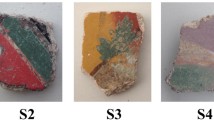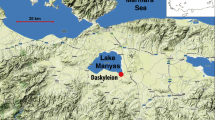Abstract
Proteinaceous organic materials used as ancient painting media were investigated by capillary gas chromatography (GC) and capillary gas chromatography — mass spectrometry (GC/MS). Medieval wall paintings made by the tempera technique were considered and their binding media were studied by the characterization of their main chemical components. The basic methodology is based on the determination of amino acids in samples of paint layers after hydrolysis and derivatization and on the comparison with reference proteinaceous materials. Multivariate chemometric techniques were used to facilitate the recognition of the protein source from chromatographic data. To characterize the binders further, a method was developed for the determination of fatty acids, present as minor components, by GC/MS. The use of fused-silica capillary columns coated with selected stationary phases allowed the separation of amino acid and fatty acid derivatives in a single analytical run.
Similar content being viewed by others
References
Masschelein-Kleiner L (1985) In: Ancient binding media, varnishes and adhesives. ICCROM, Rome
Mora P, Mora L, Philippot P (1984) In: Conservation of wall paintings. Butterworths, London
Cennini C (1437) In: Il libro dell'arte. Neri-Pozza, Vicenza 1971
Vasari G (1568) In: Le Vite dei più eccellenti pittori, scultori e architettori, Sansoni, Firenze 1967
Murray P, Murray L (1989) In: Dictionary of art and artists. Penguin, London
Mayer R (1969) In: A dictionary of art terms and techniques, Barnes & Noble Books Harper & Row, USA
Masschelein-Kleiner L (1986) Pact 13:185–207
Halpine SM (1992) Stud Conserv 37:22–38
Kenndler E, Schmidt-Beiwl K, Mairinger F, Pohm M (1992) Fresenius J Anal Chem 342:135–141
Shedrinsky AM, Wampler TP, Indictor N, Baer NS (1989) J Anal Appl Pyrolysis 15:393–412
Chiavari G, Bocchini P, Galletti GC (1992) Science and Technology for Cultural Heritage 1:153–158
Odlyha M, Burmester A (1988) J Thermal Anal 33:1041–1052
Odlyha M (1991) J Thermal Anal 37:1431–1440
Casoli A, Palla G (1995) Sci Technol Cult Heritage 3 (in press)
Mills JS, White R (1987) In: The organic chemistry of museum objects. Butterworths, London
Marchelli R, Dossena A, Palla G, Audhuy-Peaudecerf M, Lefeuvre S, Carnevali P, Freddi M (1992) J Sci Food Agric 59:217–226
Ein*Sight, Exploratory data analysis for IBM PC systems. Infometrix, Seattle
Massart DL, Kaufman L (1983) In: The interpretation of analytical chemical data by the use of cluster analysis. Wiley, New York
Dillon WR, Goldstein M (1984) In: Multivariate analysis. Methods and application. Wiley, New York
Karpowicz A (1981) Stud Conserv 26:153–160
Pesenti FR (1973) In: Le tecniche artistiche. Mursia, Milano
Merucci C (1993) In: Preparazione e finitura delle opere pittoriche. Mursia, Milano
Author information
Authors and Affiliations
Rights and permissions
About this article
Cite this article
Casoli, A., Mirti, P. & Palla, G. Characterization of medieval proteinaceous painting media using gas chromatography and gas chromatography — mass spectrometry. Fresenius J Anal Chem 352, 372–379 (1995). https://doi.org/10.1007/BF00322235
Received:
Revised:
Accepted:
Issue Date:
DOI: https://doi.org/10.1007/BF00322235




